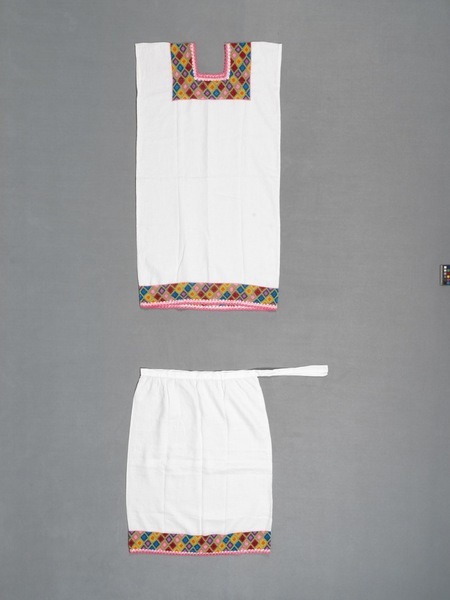Dress Item Number: 3289/59 a-b from the MOA: University of British Columbia

Description
Two part dress. The two parts are a long dress (part a) and an underskirt (part b) with an open weave or lace fringe at the bottom. The fabric is a synthetic-cotton blend. The dress is made from a single panel of fabric, sewn together on the sides with small armholes near the fold. The hem and neckline are stitched in pink. The bib open weave background colour is green with purple, red, blue, yellow, pink diamond design. This design is repeated at the hem of the dress and underskirt. The skirt has ties at the waist.
History Of Use
Yucatecan traditional huipile. Huipiles with this style of embroidery are made by creating stitches on top of an unravelled or frayed material. This technique is thought to derive from pre-Hispanic textile production styles and is unique to Yucatan. Due to a number of economic and cultural factors, this practice is in danger of extinction. These used to be made of plain natural cotton. They are now often made of synthetic cotton blend. They are always white or cream. The bib around the neck is commonly embroidered, as is the hem.
Iconographic Meaning
The flower depicted is the xmanikte, which can be translated from Maya as the eternal flower. The xmanikte resembles a quatrefoil in that it has four corners and a central point. This style resembles the Maya four directional world order that is also expressed in huipiles from other Maya speaking areas such as Guatemala. Certain examples of this design can be associated with the those recorded on ancient Maya sculpture, such as Lady K’abal Xook’s huipil in Yaxchilan lintel 24.
Item History
- Made by Veronica del Rosario Cocom (Maker) in Abala, Yucatan, Mexico during 2017
- Collected by Laura Osorio between 2017 and 2018
- Owned by Laura Osorio before April 11, 2018
- Received from Laura Osorio (Seller), Museum of Anthropology Exhibitions Budget (Funding source) and Michael O'Brian Family Foundation (Funding source) on April 11, 2018
What
- Name
- Dress
- Identification Number
- 3289/59 a-b
- Type of Item
- dress
- Material
- cotton fibre and synthetic fibre
- Part A
- height 107.5 cm, width 59.5 cm
- Part B
- height 78.5 cm, width 61.0 cm
Who
- Culture
- Mexican
- Creator
- Veronica del Rosario Cocom (Maker)
- Field Collector
- Laura Osorio
- Previous Owner
- Laura Osorio
- Received from
- Laura Osorio (Seller), Museum of Anthropology Exhibitions Budget (Funding source) and Michael O'Brian Family Foundation (Funding source)
Where
- Holding Institution
- MOA: University of British Columbia
- Made in
- Abala, Yucatan, Mexico
When
- Creation Date
- during 2017
- Collection Date
- between 2017 and 2018
- Ownership Date
- before April 11, 2018
- Acquisition Date
- on April 11, 2018
Other
- Item Classes
- textiles
- Condition
- good
- Accession Number
- 3289/0059 a-b